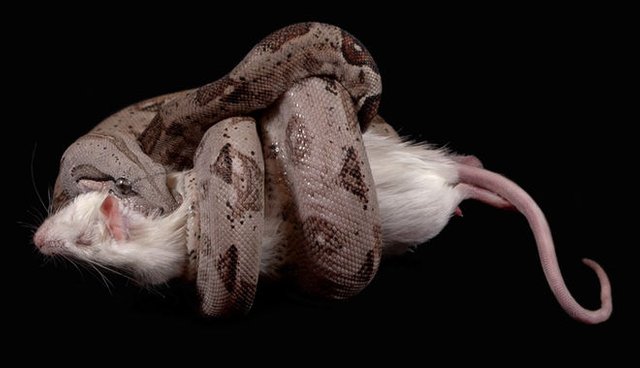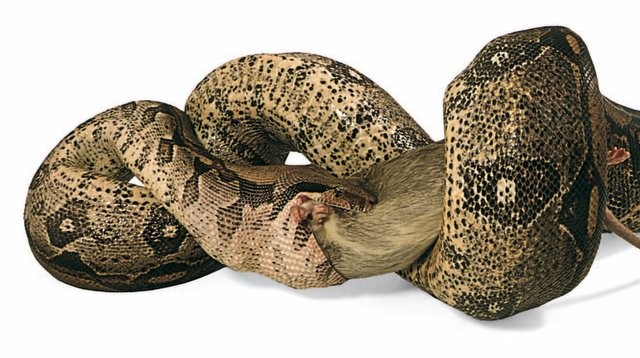How Do Snakes Know When To Stop Constricting?
Snakes are remarkably efficient predators that have evolved many different incredibly effective means of catching their prey. Some species lie in wait for days at a time, striking out with potent venom the moment their quarry comes just withing reach. Lures are occasionally employed to draw prey in for a quick kill. Faster snakes will chase down their meal with alarming speed. There is even evidence of snakes employing "teamwork" to capture food! Then there are the big guys: the constrictors. Boas, pythons and other nonvenomous snakes that kill their prey by squeezing them to death in a matter of moments.
Constrictors don't actually crush their prey to death, rather they suffocate it. When their prey enters striking distance, the snake lashes out with incredible speed, latching on with powerful rear-pointing teeth with a near inescapable grip. It uses the momentum of the strike to throw coils around its victims body, then slowly begins squeezing with immense pressure. Every time their prey exhales, they squeeze just a little bit tighter, until their prey can't inhale air at all. Completely cut off from their oxygen supply, it isn't long before the victim is killed and swallowed whole.
While we know a lot about constrictors (they are quite popular in captivity, after all!) and their unique means of killing, there is one question that hasn't been conclusively answered until now: how do these snakes know when to stop constricting their prey? Scott Boback of Dickinson College has the answer: the snakes are capable of sensing the heartbeat of their victims.
Realizing it would be very difficult to measure the heartbeat of an animal while it was being constricted by a snake, Boback came up with a creative (though somewhat creepy) alternative. Using dead rats, he created tiny artificial hearts (two water-filled bulbs connected to a pump) and inserted them inside the rats along with a pressure sensor. Using dead rats also allowed him to isolate how the "heartbeat" influenced constriction; a live subject might confuse the results with other movements like spasming muscles or panicked breathing.
Boback found that wild boas, when given their dead rat, would finely adjust their coils and constriction with the "heartbeats" of the rat. When he pumped the artificial hearts, the boas would constrict the rats for twice as long with double the pressure, compared to when the hearts were still. When he stopped beating the hearts, the boas would stop constricting only moments later. The test was then conducted on captive-bred and raised boas that had only ever eaten dead rodents. Despite never killing prey with an active heartbeat, they responded to their prey in the same manner the wild caught snakes did. However, the captive snakes did exert less pressure on the rodents suggesting that while constrictors may have an innate ability to feel their victim's heartbeat, it is up to experience to determine how strongly to constrict.
So why would a snake need to be able to monitor its prey that closely? Suffocating prey takes a huge amount of energy, and during a kill, a constrictor's metabolism can increase by 700%. Constricting prey also leaves the snake itself vulnerable to an attack by a predator. For this reason, knowing the precise moment that their prey is deceased is an incredible advantage. However, it's still not known exactly how this trait came about. Constrictors feed largely on birds and mammals, and because of their high metabolism, these animal require a lot of oxygen and can be quickly suffocated; being able to sense heartbeats would really only save the snake a few seconds. Boback provides a possible explanation: the earliest snakes from the Cretaceous period would have fed largely on ectothermic prey, many of which can slow their heartbeat and survive hours submerged without oxygen. The snakes' ability to sense heartbeats may have been useful in determining when these animals had actually perished. Alternatively, this ability could just be a beneficial side product of the snakes' sensitive skin. Snakes have an ability to sense vibrations in the ground beneath them; their ability to detect a heartbeat may just be an added bonus. Whatever the reason, constrictors are incredibly efficient killers capable of detecting the moment their prey has perished.
Article Link: http://blogs.discovermagazine.com/




@herpetologyguy Thank you For Great Information :) Big Snakes can eat Everything ^^
Snack enemies :
Great article! Truly an apex predator in many cases
Very cool!

Snakes are awesome!
I have a ball python at home. Hopefully this knowledge will help me bond with him more... Na prolly won't he's coldblooded
Really interesting! Didnt know any of this! We have a ball python and we recently switched him from live to frozen thawed. It seems like since the switch to frozen thawed he stays in "hunt" mode for a few days after. I couldn't figure out exactly why but maybe it has to do with him not having to use as much energy when he constricts?